Pressing Impossible: Amorim Loses to Hürzeler – MH
Rúben Amorim’s Manchester United faced Hürzeler’s Brighton on Matchday 22. While Manchester United focused on creating a pressing system that was as difficult as possible to bypass, Brighton once again showcased their incredibly challenging vertical play. You can find the tactical analysis of the match here.
Manchester United started in a nominal 3-2-4-1 formation, which transitioned into a classic 3-2-5 shape in possession and a 5-4-1 shape out of possession. Amorim initially placed particular emphasis on a pressing system that varied in height.
Meanwhile, Brighton began in a nominal 4-4-2 formation. In possession, Hürzeler’s trademark positional rotations, vertical runs, and decoy movements for effective vertical play were continuously on display. Accordingly, Brighton operated flexibly from a variety of shapes, such as 4-2-4, 3-1-4-2, 2-3-2-3, and more. This flexibility makes Brighton’s possession game almost impossible to define through formations alone.
Brighton’s Dominance in the Early Stages
Manchester United initially operated out of a 5-4-1 shape with varying defensive heights. This approach made it challenging for the opposition to play through, as different build-up phases required distinct patterns and connections. United’s central midfielders in the four-man line marked Brighton’s double pivot, Ayari and Baleba, man-to-man. The goal was to gain optimal control of Brighton’s central build-up play and apply immediate pressure whenever Brighton played through the middle.
However, Brighton controlled the game during the first 10 minutes. Their holding midfielders positioned themselves close to the backline, creating a large gap between Manchester United’s five-man defensive line and the four-man midfield. This space was then exploited with various runs. When facing high pressing, left-back Estupiñán moved asymmetrically into the left half-space behind United’s first pressing block. This movement utilized the moment when Amad stepped out to press one of Brighton’s center-backs after bypassing Zirkzee.
United failed to adjust their pressing to this build-up variation throughout the match. As a result, this same pattern played a key role in Brighton’s build-up to the goal that made it 1-3.
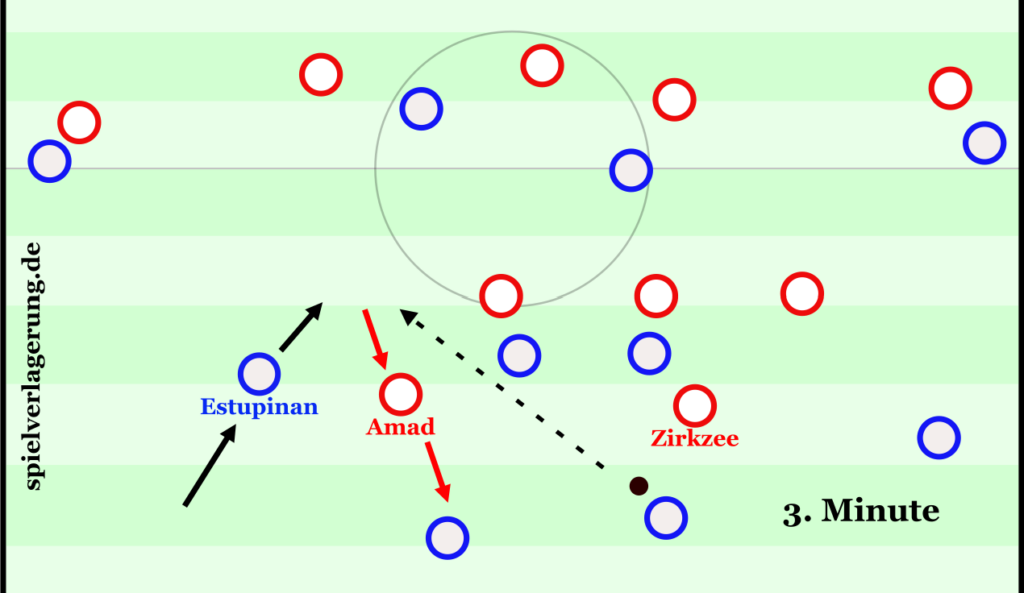
Against Manchester United’s mid-block, Brighton’s strikers, Welbeck and João Pedro, alternated their runs into the large space between the lines, targeting the gaps. This repeatedly allowed Brighton to bypass United’s first pressing line.
The 1-0 goal resulted from this setup, facilitated by a counter-movement. As striker Welbeck made a run into the space between the lines, he pulled his marker, De Ligt, a few steps out of the five-man backline. Simultaneously, winger Mitoma made a deep run into the space that opened up. De Ligt was caught in a dilemma between applying pressure and covering the depth. A long ball bypassed United’s entire pressing structure, leading to the goal.
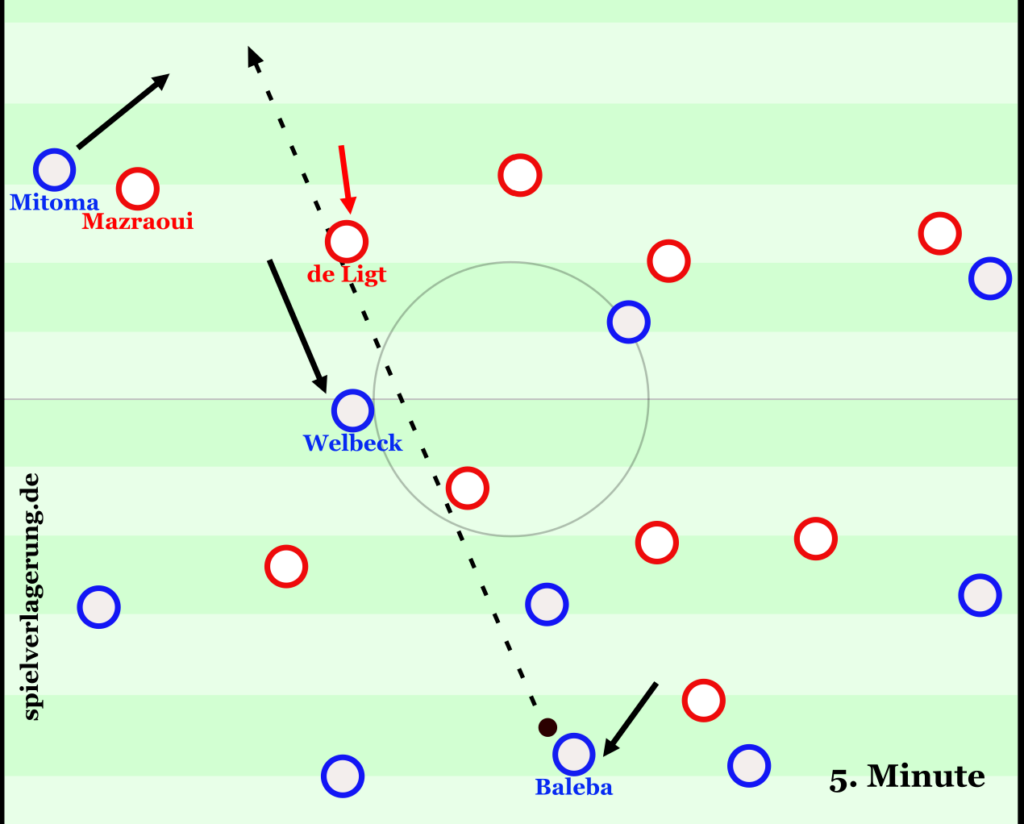
Another reason for Brighton’s dominance in the first 10 minutes lay in their defensive work. United built up in a very positionally structured 3-2-4-1(/-5) shape. Brighton countered with a 4-4-2 in their high press and a 5-4-1 in their mid-block. With Minteh marking Diogo Dalot man-to-man on the flank, the two different defensive shapes emerged depending on Dalot’s positioning. Brighton’s two strikers also pressed United’s center-backs, Maguire and Yoro, on that side, applying intense pressure on the ball carriers on United’s left.
On the other side, winger Mitoma positioned himself centrally when De Ligt had possession, cutting off the passing lane to Amad, who was positioned in the half-space. If the ball was played to full-back Mazraoui, Mitoma shifted out from the center to press, creating a cover shadow into the center. This approach effectively prevented United from creating any significant attacking threat on that flank as well.
Manchester United’s Adjustments
Around the 10th minute, the game shifted, and Brighton’s dominance began to fade. This was due to several adjustments made by United. To reduce the pressure on the ball carrier on the left side, the highly press-resistant Bruno Fernandes started to drop deeper, while the full-backs pushed higher. The resulting 3-3-4 shape was difficult for Brighton to press, as full-back Veltman, or the half-space defender in the five-man backline, was pulled out, and the space in behind could be exploited by either full-back Dalot or striker Zirkzee. This led to more possession phases for United and fewer pressing phases from Brighton.
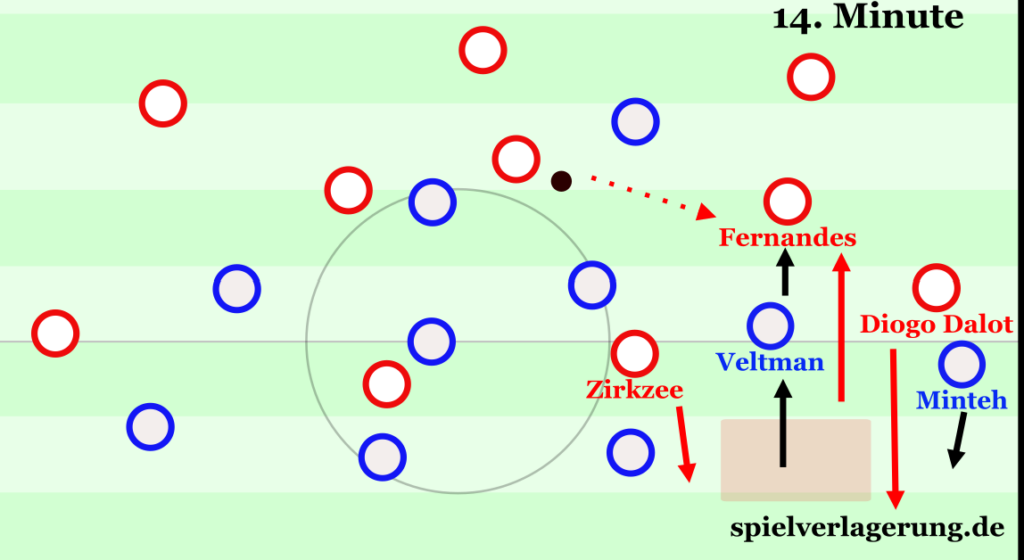
Another adjustment United made came from their 5-4-1 mid-block. The half-space defenders, De Ligt and Yoro, became much more aggressive in stepping out from the five-man backline to defend against the strikers making runs into the large space between the lines. This prevented Brighton’s strikers from turning after bypassing the first pressing block. To defend long balls to Mitoma, Mazraoui prioritized covering the space behind the advancing De Ligt. As a result, Brighton struggled to exploit the space between the lines and couldn’t progress as effectively into depth from their own possession.
Additionally, Manchester United no longer pressed situationally from a 5-4-1 in a high press but instead switched to man-marking, with Zirkzee following the goalkeeper. This created much more pressure on the ball carriers for Brighton. Brighton also faced difficulties because the 5-4-1 system is much harder to break down than man-marking in a high press. This became evident in the sequence leading to the penalty goal. United suddenly switched to man-marking and forced the ball loss that preceded the penalty. United deservedly equalized.
Brighton in Search of Solutions Against the 5-4-1 Mid-Block
After the 1-1, the game became more balanced. Brighton tried to break down the 5-4-1 mid-block, while United focused on their defensive game. When Manchester United switched to man-marking in the high press, Brighton continued to struggle and often lost possession. It is questionable why United didn’t press more boldly and high man-to-man during this phase to maintain better control of the game.
From Brighton’s perspective, a situational, more extreme overload at the moment of transition into high pressing—such as in the central space just behind the first pressing block—could have been a possible solution to challenge United’s man-marking, putting them in a dilemma between applying pressure and defending 1v1 on the wings.
In possession, Brighton’s players frequently adjusted their positioning with small movements, creating new passing lanes, changing passing angles, and occupying spaces that forced the opponent into pressing reactions. Below, I have outlined the main advantages of three of the most frequently used shapes by Brighton against United, as well as the necessary reactions from the opponent.
4-2-4:
- Double width on the flanks provides attacking breadth
- The opponent is stretched out
- Space in the center for strikers to drop into
- Defense must maintain compactness in the center
2-3-2-3:
- Control of the center through numerical superiority
- Closer passing distances enable faster combinations
- More effective counter-pressing
- Defense must react to numerical inferiority in the center
3-1-2-4:
- Occupying the half-space and the last line lures half-space defenders
- Numerical superiority in front of the opponent’s defensive line
- Wide defenders in the three-man build-up can drive into the half-space
- Defense must react to half-space dominance in front of the defensive line
- Defense must react to the dribbling runs of the build-up players when necessary
Another factor that makes Brighton’s vertical play difficult to defend is the continuous variety of space-creating or counter-movement runs into depth. These consistently create dilemmas and positional problems for the defenders. Below, I have graphically illustrated some selected runs used against United:
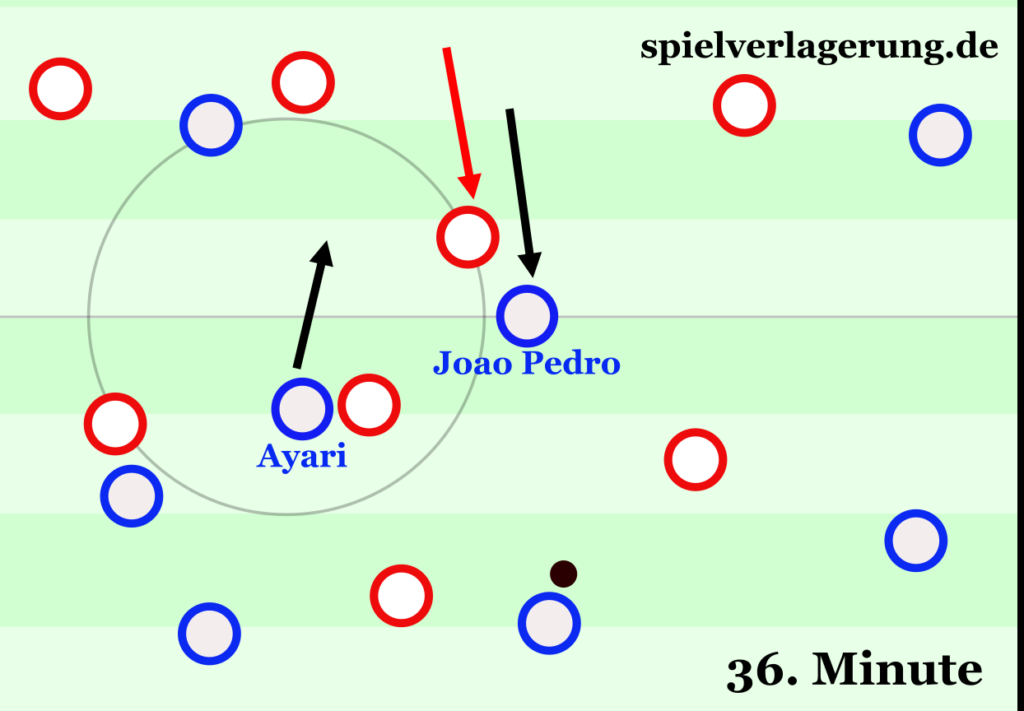
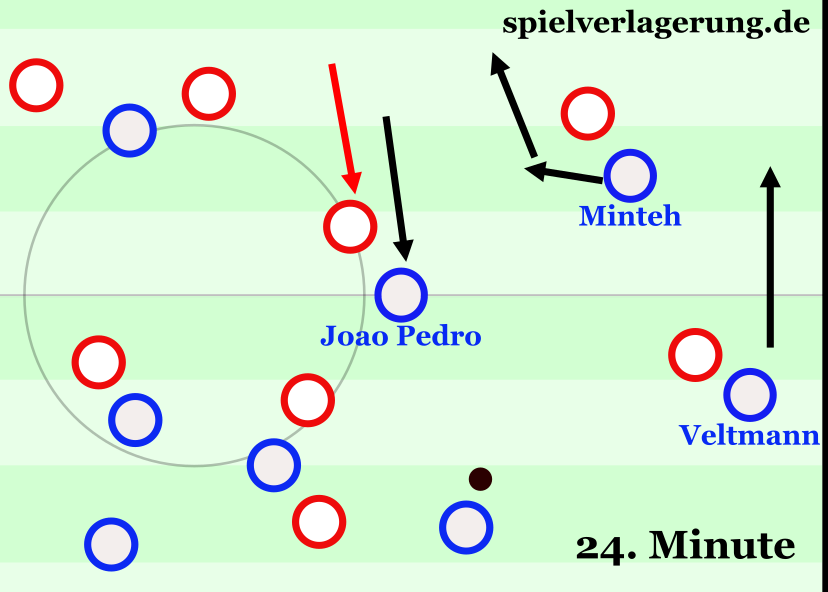
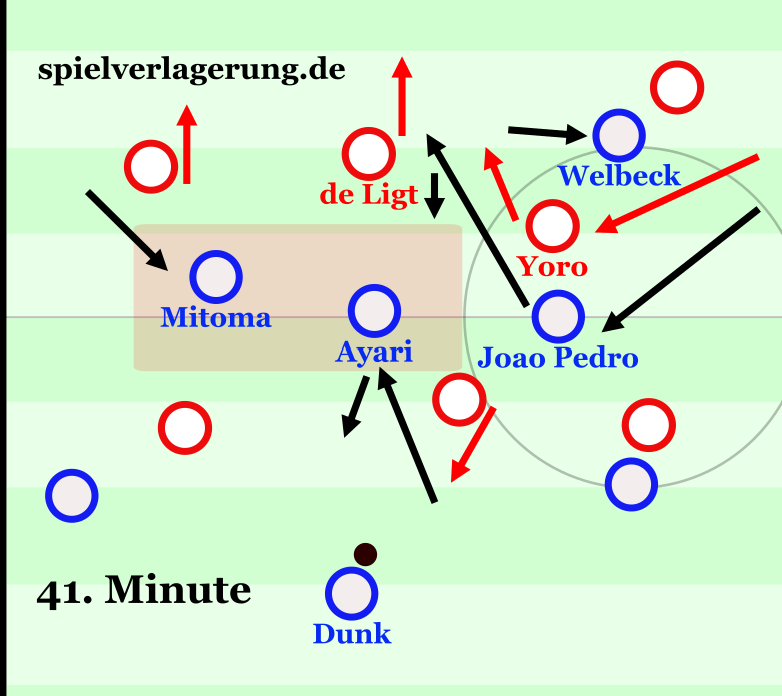
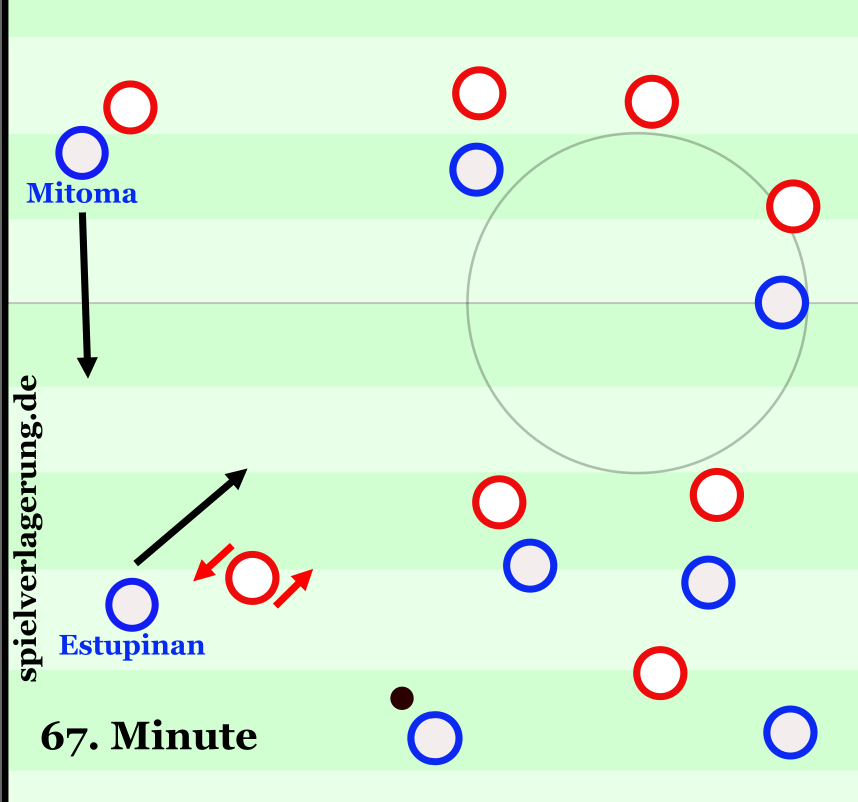
Despite Brighton’s possession game, Manchester United was able to prevent significant goal-scoring opportunities initially. From their 5-4-1 structure, the center-backs repeatedly defended aggressively, stepping out. Additionally, after bypassing the four-man midfield, it would drop back into position. This “recovery defense” made it difficult for Brighton to develop effective build-up play and exploit opened spaces. Furthermore, United’s players were well-prepared for potential through balls. In particular, the full-backs consistently intercepted balls played behind the defensive line.
Brighton’s Recurring Dominance
Towards the end of the first half and into the second half, small (forced?) mistakes began to creep into United’s pressing. While the failure to step out with Ugarte in the man-marking high press in the 39th minute and the failure to step out with De Ligt in the space between the lines in the 38th minute went unpunished, the delayed step-out by Yoro led to Brighton’s deserved 1-2 at that point.
Especially in the second half, Brighton adapted to the man-marking high press by having center-backs step inside, breaking free from the cover shadow, when pressing the goalkeeper. This allowed them to find the open player in build-up, and Brighton lost possession less frequently.
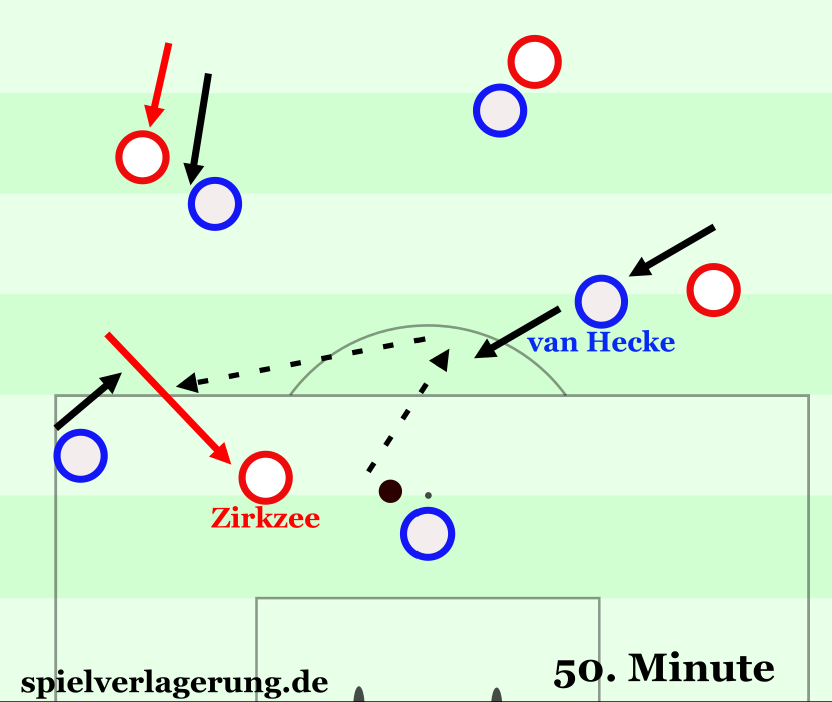
Longer defensive phases in the mid-block for Manchester United followed. To break down this block, Brighton’s possession play became less positionally rigid. Much more frequently, certain zones were overloaded. In particular, the space between the lines and the half-spaces were repeatedly occupied by multiple players to create numerical superiority and apply pressure.
United, on the other hand, struggled to create any significant goal-scoring chances. The high press could have been more effective with a brief orientation from the player pressing the goalkeeper to position the inward-dropping center-back into a cover shadow. From the 5-4-1 mid-block, too few dangerous ball recoveries and transition situations were created.
Even from their own possession, Manchester United created too few goal-scoring opportunities. When Amorim’s team did get chances, it was typically through a ball played behind the wide players of the five-man backline. At the moment the press was triggered (when Brighton stepped out to the outer center-back), the forward half-space player dropped deep, and the winger made a run in behind. However, the lack of other ways to break the press led to too much predictability in United’s possession play.
As a result, the second half became more one-sided, with Brighton repeatedly pressing and trying to put United’s press under pressure. This ultimately succeeded, leading to a deserved 3-1 victory for Hürzeler’s team.
Conclusion
Amorim’s press, which was difficult to break down, was ultimately cracked by Hürzeler. It is questionable whether more frequent defensive pressing, alternating with situational man-marking high pressing, might have been a better approach against Brighton, in order to better tighten the space between the lines and the area behind the defense, making the game in depth more difficult. Despite a higher mid-block, Manchester United hardly created any dangerous transition situations. This is an area that needs improvement.
Hürzeler’s team, on the other hand, once again played highly attractive possession football. Frequent positional rotations, shifts in formations, overloads, and space-creating runs make Brighton’s possession game very enjoyable to watch. For the opponent, these constant shifts in zones over an extended period are incredibly difficult to defend. It is very likely that we will see more teams adopting similar principles in possession in the future.
Author: “MH” is a young analyst who regularly produces content for Spielverlagerung NextGen and TotalFootballAnalysis. On X, he can be found under Mh_sv5.


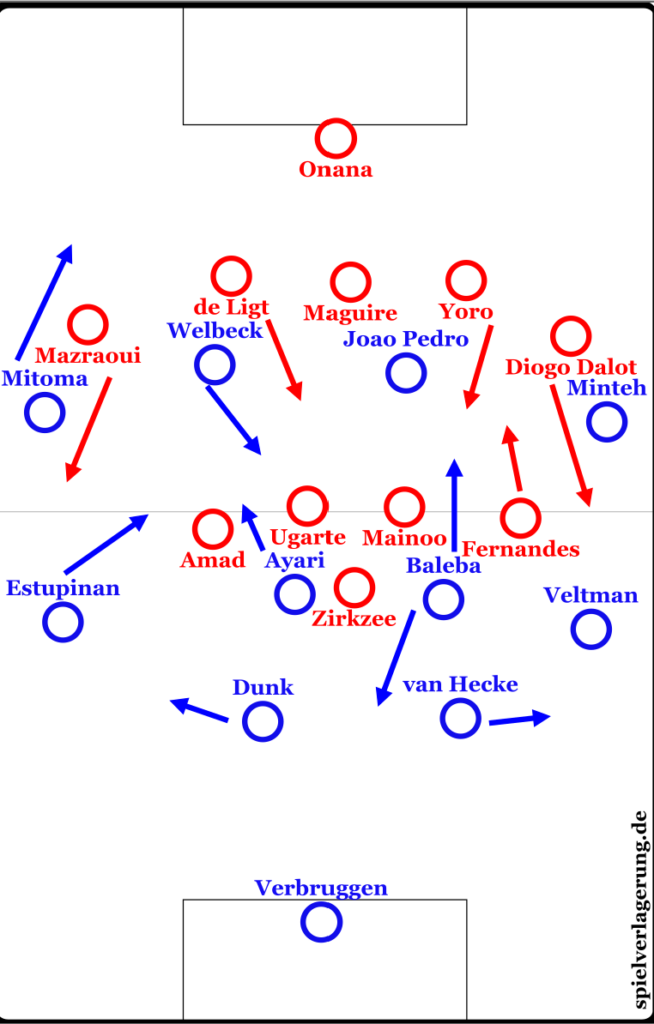
Keine Kommentare vorhanden Alle anzeigen